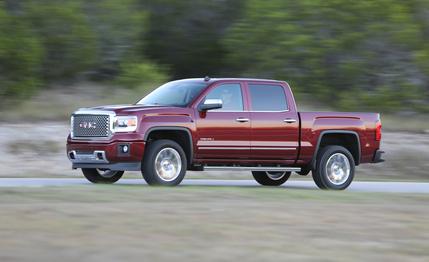
 First Drive Review
First Drive Review
Big Tex, the 52-foot-tall ambassador of the State Fair of Texas, met a fiery demise on the last day of the 2012 fair, exactly 60 years to the day after his debut. Ever the resilient bunch, the good people of the Lone Star State aimed to rebuild the barrel-chested and slightly creepy icon in time for the 2013 fair, and we’re happy to report they succeeded with flying—and likely less flammable—colors.
So what does the now 55-foot-tall cowboy statue have to do with the new Chevrolet Silverado High Country, the new GMC Sierra Denali, and the new 420-hp, 6.2-liter Ecotec3 V-8 that powers them both? (The engine is also available as a $1995 option in the trucks’ respective LTZ and SLT models, but we drove the engine in the poshest trims.) Well, the whole lot inspires nearly pathological levels of excitement and state pride among native Texans, and GM’s debuting its latest high-zoot trucks within spitting distance of the new and improved Big Tex is no coincidence. GM execs informed us that one of every seven full-size Chevrolet and GMC trucks is sold in Texas, which also is home to three of the top seven GM truck dealers in the country. (Houston is number one overall, Dallas is second, and San Antonio is seventh.) Only a Longhorns/Aggies football game played on bullback in a fully operational oilfield could have out-Texas’ed the whole affair.

 The resurrected Big Tex greets 2013 fairgoers. (Credit: Kevin Brown/State Fair of Texas)
The resurrected Big Tex greets 2013 fairgoers. (Credit: Kevin Brown/State Fair of Texas)
We have previously tested the 2014 Silverado and Sierra with the 5.3-liter V-8, so for us, this experience was all about the 6.2-liter small-block V-8 engine, despite the obvious trim and interior upgrades that come with a High Country and Denali purchase. GM isn’t shy about letting it be known that the engine shares more than displacement with the V-8 from the C7 Corvette, counting the aluminum block, bore spacing, crank, and pistons among the common components. The intake, the exhaust, the fuel and ignition mapping, the lubrication, and other ancillary components have been optimized for truck duty, though, resulting in smooth, refined power delivery that doesn’t announce its arrival with an overly obnoxious exhaust note. Sure, there is the provocatively named “exhaust flapper,” a bypass valve that lets the V-8 speak up under heavy throttle and while performing feats of towing strength, but it otherwise has no audible giveaways to its 420 horsepower and 460 lb-ft of naturally aspirated grunt. Indeed, both trucks are equipped with active noise cancellation when ordered with the 6.2-liter engine, to reduce annoying rumble when cruising and at low engine speeds.
The 6.2-liter performs the same cylinder-deactivation trick as the 5.3, shutting down four cylinders almost imperceptibly under light- and no-load situations. Larger 9.76-inch rear axles are fitted to cope with the 6.2-liter’s prodigious power, and the six-speed transmission goes about its business without ever raising a fuss. When asked if the six-speed box might seem a little antiquated, GM told us that customer research indicated its buyers highly valued “proven performance,” which also played into the decision to stick with a naturally aspirated engine. (Fun fact: GM’s pickup-development team initially anticipated co-opting this engine and assigned a truck engineer to the Corvette powertrain program early in development.) Even so, a GM-designed eight-speed automatic should be swapped into the company’s full-size trucks and SUVs sometime in the next couple of years.